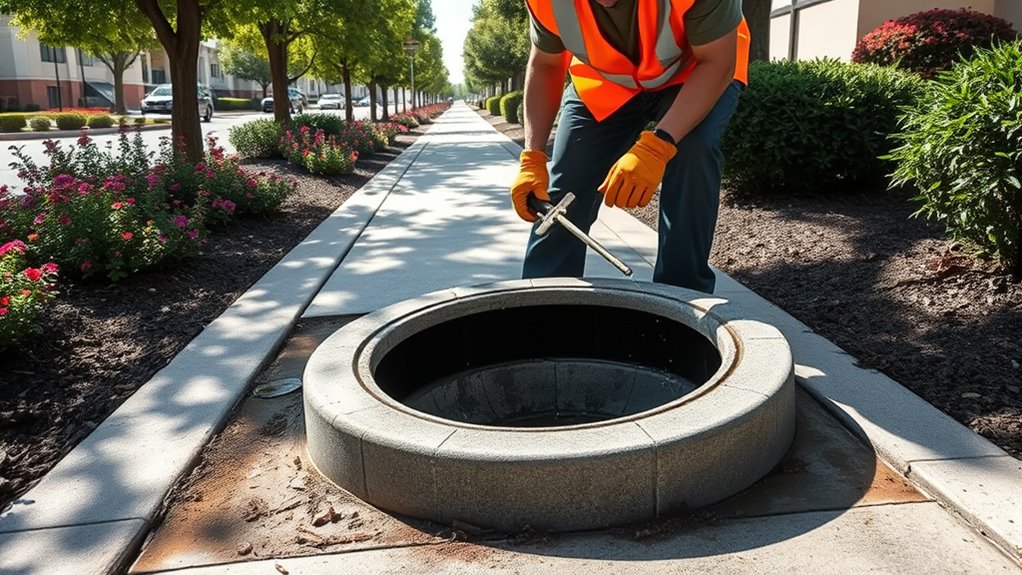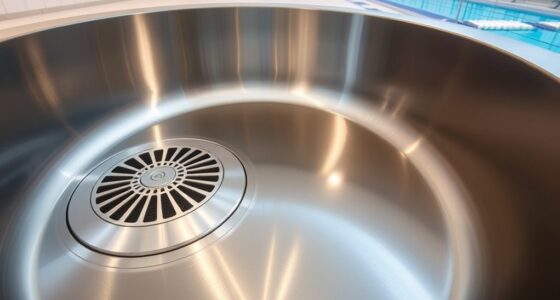To keep your catch basin functioning properly, regularly inspect it after heavy storms or during fall when leaves fall. Clear away debris like leaves, trash, and dirt using sturdy tools, and check the inlet and outlet pipes for blockages or damage. Schedule inspections during dry weather for easier access and keep a maintenance log. Proper upkeep prevents flooding and property damage. Continuing to care for your catch basin helps ensure effective stormwater drainage; stay tuned to discover more helpful tips.
Key Takeaways
- Regularly inspect catch basins after storms and during dry weather for debris buildup or blockages.
- Remove leaves, trash, and sediments using appropriate tools, ensuring the area stays clean and safe.
- Check inlet and outlet pipes for obstructions or damage, and clear any lodged debris.
- Examine the basin structure for cracks or deterioration, scheduling repairs if needed.
- Keep detailed maintenance logs and mark basins for future inspections to ensure ongoing functionality.

Regular maintenance of your catch basin is essential to keep stormwater flowing smoothly and prevent flooding. When you stay on top of routine checks, you’re actively supporting effective stormwater management in your area. Catch basins are designed to trap debris, leaves, and other materials that can clog the system. If you neglect this task, these obstructions can cause water to back up, leading to localized flooding and property damage. Regular debris removal ensures that water can move freely through the basin and into the drainage system, reducing the risk of standing water or overflow during heavy rains.
Start by inspecting your catch basin after significant storm events or at regular intervals, especially during fall when leaf fall increases debris. Look for signs of blockage, sediment buildup, or standing water inside the basin. Clear out any accumulated debris, such as leaves, trash, or dirt, using a sturdy shovel or scoop. Removing debris not only helps maintain stormwater management efficiency but also prevents the basin from becoming a breeding ground for pests or mold. Be sure to wear gloves and dispose of debris properly, keeping your work area clean and safe.
As you perform debris removal, check the inlet and outlet pipes for blockages or damage. Sometimes, debris can get lodged further into the system, so it’s important to clear those areas as well. If you notice any cracks or deterioration in the basin itself, consider scheduling repairs promptly to avoid future issues. Maintaining the structural integrity of your catch basin is just as important as clearing debris, as broken or damaged basins can fail to perform during storms.
In addition to physical cleaning, consider marking or labeling your catch basin to remind yourself of future maintenance needs. If your basin is located in a hard-to-reach area, plan ahead for easier access during inspections. Keep a maintenance log to track when you last cleaned the basin and note any repairs or observations. This record can be useful if issues arise or if you need to coordinate with local stormwater management authorities. Understanding stormwater hydraulics can help you better assess how your catch basin contributes to overall drainage performance.
Regular upkeep of your catch basin isn’t just about avoiding nuisance flooding; it’s about actively contributing to effective stormwater management in your community. By dedicating a little time to debris removal and visual inspections, you help ensure that rainwater drains efficiently, protecting your property and reducing the burden on municipal drainage systems. Staying proactive with catch basin maintenance is a simple yet crucial step towards managing stormwater responsibly.
Frequently Asked Questions
How Often Should Catch Basins Be Inspected for Optimal Performance?
You should inspect your catch basin at least once every three to six months to guarantee peak performance. An effective inspection schedule helps identify debris buildup, blockages, or damage early, reducing the risk of flooding or backups. Adjust the maintenance frequency based on your local climate, surrounding environment, and rainfall patterns. Regular inspections keep your catch basin functioning properly, preventing costly repairs and maintaining efficient stormwater management.
What Signs Indicate a Catch Basin Needs Urgent Cleaning?
If you notice clogged grates that cause water to back up or foul odors emanating from the basin, it’s time for urgent cleaning. These signs indicate debris buildup and blockages that can lead to flooding or water quality issues. Don’t delay; prompt action prevents problems from worsening. Regular inspections help catch these signs early, ensuring your catch basin functions flawlessly and keeps your surroundings safe and sanitary.
Are There Specific Tools Recommended for Catch Basin Maintenance?
You should use specialized tools like a catch basin hook or a scoop to effectively remove debris, ensuring thorough cleaning. Always wear safety equipment such as gloves, goggles, and a mask to protect yourself from potential hazards. These tools help you reach deep inside the basin and lift out blockages safely, making maintenance quicker and more efficient. Proper tools and safety gear are essential for maintaining the catch basin’s functionality and your safety.
Can Routine Maintenance Prevent Flooding in Urban Areas?
Yes, routine maintenance plays a crucial role in preventing urban flooding by ensuring effective stormwater management. When you regularly clean and inspect catch basins, you help keep debris out of drainage systems, reducing blockages. This proactive approach allows water to flow freely during heavy rains, minimizing flood risks in urban areas. Consistent upkeep of catch basins directly contributes to healthier stormwater management and safer, flood-free communities.
What Are the Environmental Impacts of Neglecting Catch Basin Upkeep?
Neglecting catch basin upkeep is like ignoring a leaking faucet—it causes bigger problems. When you skip maintenance, stormwater pollution worsens, carrying trash and harmful chemicals into waterways. This harms aquatic habitats and disrupts habitat preservation efforts. Over time, debris buildup blocks water flow, increasing flood risk and contaminating water sources. Regular catch basin care helps protect the environment, keeping urban areas clean and healthy for both people and wildlife.
Conclusion
By staying on top of routine catch basin maintenance, you’re practically saving your entire neighborhood from flooding disasters and chaos! Neglect it, and you risk turning your streets into rivers straight out of a disaster movie. Don’t let debris and blockages turn your drainage system into a ticking time bomb. Keep up with maintenance, and you’ll be the hero who prevents chaos, saves your community, and keeps everything flowing smoothly—like a well-oiled flood-free machine!









